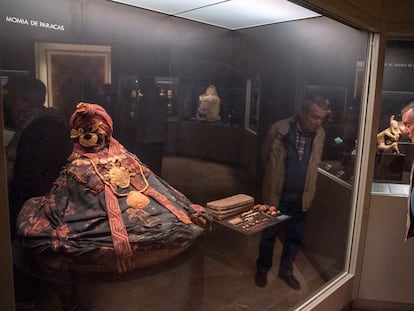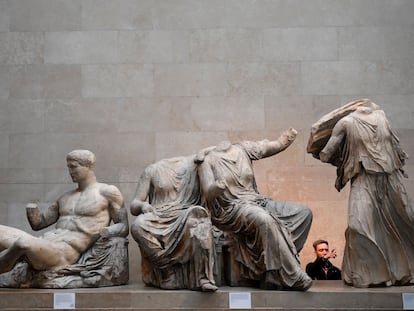Museums in Europe and the United States confront their colonial past
Many countries have begun to return pieces that were looted during periods of colonization. Experts are also researching the origins of stolen collections. Some parties, however, have resisted coming to agreements
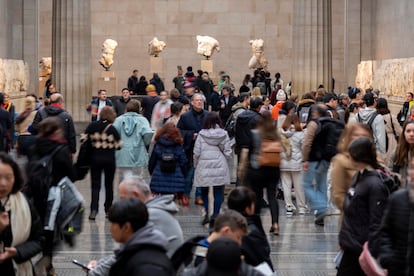
Last week, Spanish Minister of Culture Ernest Urtasun announced that the state’s museums would begin a review process of their collections. The goal is to “overcome a colonial framework, or a framework anchored in gender or ethnocentric inertia, that has often hindered the vision of heritage, history and artistic legacy.” The announcement has generated a heated debate in Spain, as has occurred in many countries where similar policies have been implemented or proposed.
In the museums of former colonial powers, there’s an abundance of pieces extracted from the territories that were once occupied and plundered. This theft — once seen as natural — has caused discomfort for some years now, which is why the decolonization processes in museums are at the forefront of how these institutions operate today.
What policies should be developed to return stolen pieces to former colonies? Some countries — such as France — have already made progress in returning a small amount of the stolen pieces to African countries, such as Benin or Senegal. In the United Kingdom, the British Museum and the Victoria & Albert Museum have lent dozens of objects that were plundered from the Asante people to Ghana — a former British colony — for three years. However, when it comes to the institution holding many of the Parthenon Sculptures, the notion of returning them becomes difficult: it’s awkward to admit to the plundering.
Other countries are looking for their own formulas to address this issue, and the processes certainly aren’t without controversy. EL PAÍS correspondents have reported on the ongoing situation in the countries where the debate is most heated.
France: ambitious goals, complex processes
By: Marc Bassets, Paris
In 2017, Emmanuel Macron launched an ambitious plan to restore African heritage that was being kept in French museums. However, while the return of stolen art remains a pillar of the French president’s battered African policy, the process is complex and slow.
Several objects have been returned to Benin and Senegal (former French colonies), but they’re an infinitesimal part of the 88,000 objects from sub-Saharan Africa in France’s public collections. One difficulty is establishing exactly which of these left Africa illegitimately. The museums with the most works — led by Musée du Quai Branly-Jacques Chirac — are working on identifying pieces that can be returned, if there’s a claim pending.
In 2018, a report by specialists Bénédicte Savoy and Felwine Sarr argued that Paris should respond positively to African demands for the restitution of objects stolen in the context of war, collected during “scientific missions” before 1960, or delivered to French museums by agents of the colonial administration. But there was one caveat: that the absence of abuse in the transactions be demonstrated. Another report from 2023 — written by Jean-Luc Martinez, a former director of the Louvre, — specified that the “illegal” or “illegitimate” nature of the acquisition had to be demonstrated. A future law — pending debate and vote in the French Parliament — will regulate restitutions.
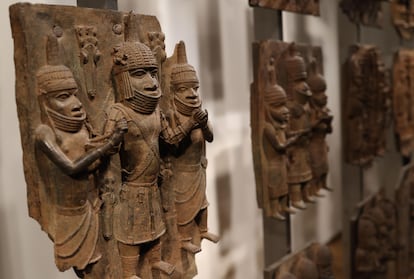
United Kingdom: beyond the sculptures of the Parthenon
By: Rafa De Miguel, London
The British Museum and the Victoria & Albert Museum recently announced that they will lend Ghana dozens of objects for three years. These pieces — looted as war booty by imperial troops in the African region during the 19th century — originally belonged to the Asante people. This case is the perfect example of the complex debate on decolonization that the U.K. is going through.
Just like the failed attempts by the British Museum’s leadership to devise a formula that would allow the return of the Parthenon Sculptures to the Acropolis in Athens (the most high-profile European case when it comes to the restitution of art), any imagined solution must be expressed in the form of a loan, an exchange of works, or a joint exhibition. Simply and plainly, the possibility of admitting that many pieces contained in museums were acquired illegally — essentially acknowledging that their return is an ethical obligation — still faces many obstacles.
These are political barriers, first of all, because the Conservative Party has decided to wage a culture war against what it considers to be leftist revisionism of imperial history. And there are also cultural obstacles, because in the museum field, there’s still the notion that certain institutions are responsible for preserving the cultural heritage of humanity, with the mission to offer a global narrative of culture.
Faced with this vision — which many consider to be biased and paternalistic — increasingly powerful movements have emerged among art professionals. One such network is Museum Detox, which promotes exhibitions and conferences to achieve greater awareness of diversity and the colonial traces left behind in museums. Various campaigns — such as the one carried out in Oxford under the slogan “Rhodes Must Fall,” which seeks the removal of the statue of the founding mining businessman of the apartheid state of Rhodesia — have managed to shift the position of intransigent university authorities. The statue is still there, but a plaque at its feet now explains who Rhodes actually was. And, what’s more important: scholarships and aid have been increased for students of African descent and, in general, for all ethnic minorities.
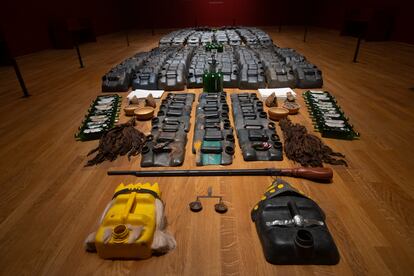
The Netherlands: repatriation is a possibility, if requested by the country of origin
By: Isabel Ferrer, The Hague
In 2020, the Council for Culture — an advisory body to the Dutch government — contemplated the return of colonial cultural heritage seized by the Dutch between the 17th century and 1975. The report that was issued recognized the injustice committed and opened the doors to the return of some 450,000 pieces. In 2022, Prime Minister Mark Rutte apologized for the Netherlands’ colonial past and for its role in the international slave trade. The review of the Royal Collections — property of the reigning monarchy — is also underway.
For any restitution of this kind to be possible, the objects must be requested by the countries of origin. An exhaustive investigation must also be carried out. The Colonial Collections Committee — an independent body — is responsible for analyzing each case. In July 2023, 478 objects — which had ended up in Dutch museums via coercion — were returned to Indonesia and Sri Lanka. Among the collections handed back to Indonesia was the Lombok treasure, made up of jewels that were looted by the Dutch colonial army at the end of the 19th century.
Not all colonial art was stolen: there were also purchases and gifts. Hence, prior study is required to clear up doubts. Based on dialogue between the Netherlands and aggrieved parties, agreements may emerge that allow for certain works to be kept in Dutch museums, if the institutions are deemed to be appropriate for the conservation and exhibition of the pieces.
From the end of the 16th century, Dutch colonial expansion relied on extensive financial networks to carry out intense commercial activity, which included the international slave trade. The Dutch East and West India Companies divided up the business and mostly operated in Southern Africa and Asia — in present-day Indonesia — as well as in Suriname, Brazil and the Caribbean. In 2022, the Museum of the Tropics — today renamed the Museum of the World — opened a permanent exhibition on 400 years of colonialism, so as to encourage debate among the public. The Netherlands didn’t recognize Indonesian independence until 1949.

Belgium: reflecting on a brutal past
By: Silvia Ayuso, Brussels
For years, Belgium has been embarking on an exercise of decolonization and reflection on how to explain its brutal colonial past in what is now the Democratic Republic of the Congo (DRC). The country’s authorities have also been determining how to return at least part of the works that were looted and are now being claimed by their countries of origin. This process was accelerated after the Black Lives Matter demonstrations of 2020, following the murder of George Floyd at the hands of a white police officer. The wave of global protests reached Belgium, with actions being taken against colonial symbols. Statues of figures such as King Leopold II — the Dutch monarch who carried out was perhaps the largest genocide in history in the Congo from 1885 until his death in 1909 — were vandalized with red paint. These actions still occur frequently.
Years before this, however, in 2013, the ultimate symbol of the Belgian colonial past — the Royal Museum of Central Africa, on the outskirts of Brussels — closed its doors. It would no longer be “the last colonial museum in the world,” vowed Guido Gryseels, the museum’s then-director. It reopened five years later as a space that — through its vast exhibitions — attempts to offer a more critical look at Belgium’s role as a colonial power. It has even removed some works — such as the famous Leopard Man and numerous busts — which require better contextualization. According to Bart Ouvry — the current director — these works “need subtitles.”
In the summer of 2022, the Belgian Parliament took a key step by passing a law to “recognize the alienable nature of assets linked to the colonial past of the Belgian state and determine a legal framework for their restitution and return” to the DRC, Rwanda and Burundi, all former colonies. The regulations establish which assets are returnable — they must be property of the Belgian state and come from museums and other “federal scientific establishments” — and establish the protocol to begin the process, which must be the result of a “concluded treaty” with the country of origin of the claimed work. Each work must also be submitted to a “scientific examination” and receive a recommendation from a joint scientific commission established for this purpose. If it’s not possible to immediately return the work, the Belgian state will preserve it under the guarantee of “inalienability, imprescriptibility and non-seizureability” during the period that it is held for.
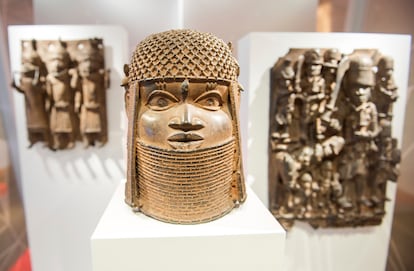
Germany: returning the Benin Bronzes
By: Elena G. Sevillano, Berlin
The return of the famous Benin Bronzes to Nigeria has been just the beginning of a radical change in Germany regarding the restitution of looted art. In 2022, the ownership of a thousand pieces — stolen by British troops in 1897 from the Royal Palace in Benin — was transferred to Nigeria, a true historical milestone in the process of decolonizing Western museums. The authorities are now analyzing how to continue this path, by returning objects that were stolen from modern-day Cameroon, Namibia, Tanzania, or the Sami people. Berlin claims to be willing to return all the looted art to its rightful owners. For the moment, the pieces are being held in German museums, while the institutions explain to visitors about how they got there in the first place.
The best example of this new approach to how collections are displayed can be seen in the Humboldt Forum in Berlin, home to the ethnographic museum of the Prussian Cultural Heritage Foundation. All the exhibitions allude to the way in which the pieces were acquired. When the provenance hasn’t been determined, not even the originals are shown. Instead, copies are exhibited (while some display cases have been left empty) to raise awareness among visitors about the colonial plundering of heritage. This process — which caused the inauguration of the Humboldt Forum to be delayed for several months — is now being repeated in museums across Germany, while teams of researchers have been created to determine which other objects should return to their countries of origin.
Portugal: an inventory of the colonies
By: Tereixa Constenla, Lisbon
One of the most symbolic gestures regarding the decolonization of Portuguese historical and cultural heritage occurred in mid-2023. The University of Coimbra began advocating for 29 skulls to be returned to East Timor. They belonged to the inhabitants of a mountain village, who were decapitated by Timorese soldiers in service of Portugal in the Laleia War (1878-1881). Shortly afterwards, the remains of the murdered people were transferred to the Department of Life Sciences of the University of Coimbra, for the use of research about racial differences, a popular field at the time. Although Timor hasn’t made an official request, the Portuguese institution is in favor of returning the skulls to their country of origin.
But the debate is older and also affects museums. At the end of 2022, Minister of Culture Pedro Adão e Silva announced the preparation of an inventory on the heritage from the Portuguese colonies in Asia and Africa, so as to determine which pieces were obtained in a violent context, or as a result of looting and theft. Although the complete list is still unknown, some cases have already been identified at the National Museum of Archeology in Lisbon and at a municipal museum in Figueira da Foz. At the time of the publication of this report, no goods have been returned to the former colonies.
The United States: a review of history, ordered by law
By: María Antonia Sánchez-Vallejo, New York City
Obliged by the justice system — which is tracking and seizing works of art of dubious origin at a rapid pace — and pressure from foreign governments, the main museums in the United States have addressed the issue of cultural property, applying a magnifying glass to the origins of the pieces in their collections… and the means by which they were acquired.
Across the main institutions, there’s a three-pronged consideration: in addition to pieces from cultures that were plundered during colonialism, there are also pieces from Indigenous cultures in North America, as well as art from Nazi looting. This past Friday, the American Museum of Natural History announced that it will close two rooms dedicated to Native peoples while new federal government regulations — which require the consent of the communities to display their works — are applied. Museums across the country have made the same decision, as curators determine whether they can be displayed under new federal regulations.
With respect to pieces from other countries, the Metropolitan Museum of Art in New York is championing the review, with radical scrutiny of its collections spurred by foreign claims.
It’s not the only one: major U.S. institutions, such as the Smithsonian — which has returned some of the Benin Bronzes to Nigeria — are settling accounts with the past, in a restitution process that has been accelerated in recent years.
The Department of Homeland Security claims that more than 20,000 objects have been returned since 2007. Most were seized from art dealers and collectors, but many were also found in some of the most prestigious museums in the United States. The Manhattan District Attorney’s Office alone — which has a specific unit focused on this — has recovered almost 5,000 antiquities since 2011.
Regarding Nazi looting, New York adopted a law in 2022 that forces museums to recognize works of art stolen from European Jews. The legislation expands the definition of this type of theft to include forced sales, specifying that, when these works are displayed, they must be accompanied by “clearly visible” signage that explains their origins. At the end of September 2023, the District Attorney forced five major museums in the country to return seven drawings by the Austrian artist Egon Schiele, which were stolen from a Holocaust victim. The trickle of repatriations is nonstop.
Translated by Avik Jain Chatlani.
Sign up for our weekly newsletter to get more English-language news coverage from EL PAÍS USA Edition
Tu suscripción se está usando en otro dispositivo
¿Quieres añadir otro usuario a tu suscripción?
Si continúas leyendo en este dispositivo, no se podrá leer en el otro.
FlechaTu suscripción se está usando en otro dispositivo y solo puedes acceder a EL PAÍS desde un dispositivo a la vez.
Si quieres compartir tu cuenta, cambia tu suscripción a la modalidad Premium, así podrás añadir otro usuario. Cada uno accederá con su propia cuenta de email, lo que os permitirá personalizar vuestra experiencia en EL PAÍS.
¿Tienes una suscripción de empresa? Accede aquí para contratar más cuentas.
En el caso de no saber quién está usando tu cuenta, te recomendamos cambiar tu contraseña aquí.
Si decides continuar compartiendo tu cuenta, este mensaje se mostrará en tu dispositivo y en el de la otra persona que está usando tu cuenta de forma indefinida, afectando a tu experiencia de lectura. Puedes consultar aquí los términos y condiciones de la suscripción digital.
More information
Archived In
Últimas noticias
David Bowie, the galactic thinker who encouraged us to break new ground
John Berger and the loss of rural culture
From police officer to bloodthirsty kidnapper: Terror in Mexico during the years of ‘The Ear Chopper’
Alain Aspect, Nobel laureate in physics: ‘Einstein was so smart that he would have had to recognize quantum entanglement’
Most viewed
- David King, chemist: ‘There are scientists studying how to cool the planet; nobody should stop these experiments from happening’
- Reinhard Genzel, Nobel laureate in physics: ‘One-minute videos will never give you the truth’
- Oona Chaplin: ‘I told James Cameron that I was living in a treehouse and starting a permaculture project with a friend’
- Sinaloa Cartel war is taking its toll on Los Chapitos
- Mexico completes its trade shift with the entry into force of tariffs on China and countries without trade agreements

